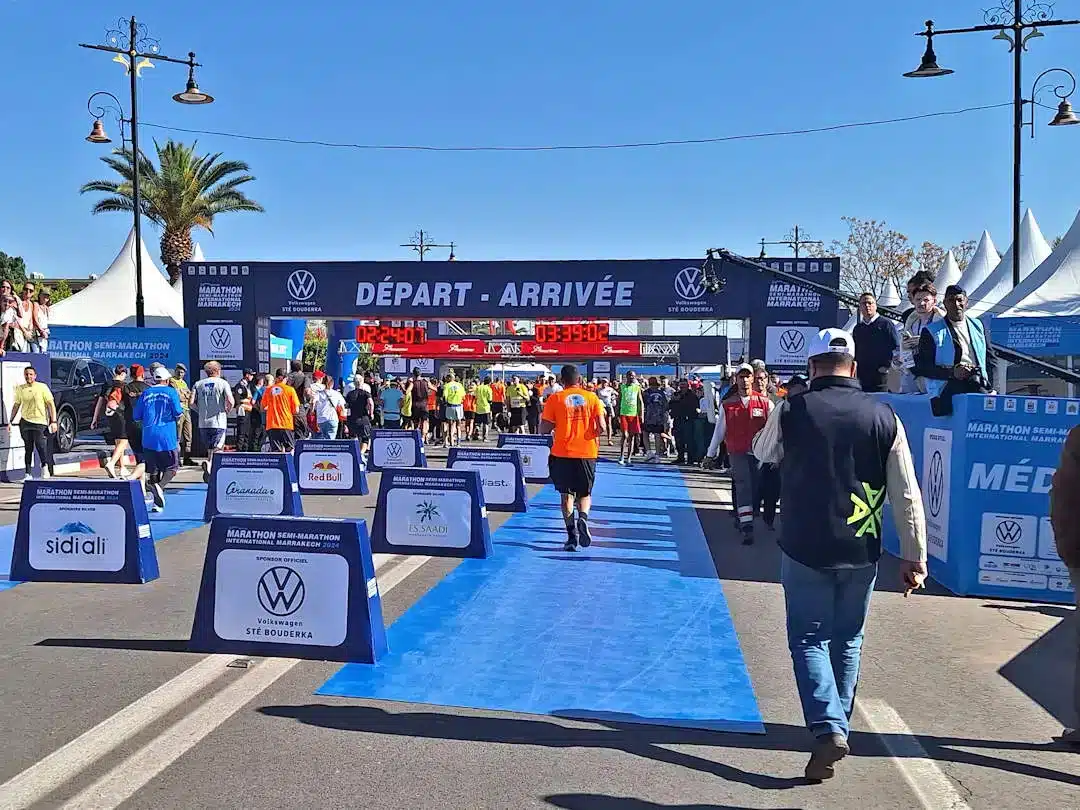Are you keen to run a marathon in Africa, but don’t know which one to choose or what to expect? My goal of running a marathon on every continent (except Antarctica) before the age of sixty, has so far taken me around Oceania (where I’ve run 20 odd events in New Zealand and Australia since age 15), North America (Los Angeles and New York City), Europe (Florence), Asia (Nagano), and now Africa, where I attended the Marathon International de Marrakech in 2024. Here is my full unbiased review and all the information you need if you plan to attend the event in 2025.
Planning your trip to Marrakesh last minute?
Book your transportation to/from Marrakesh, keeping your carbon footprint in mind:
Find your perfect accommodation in Marrakesh with Booking.com. We recommend these traditional, small-scale and centrally located options:
Purchase travel insurance for peace of mind but read the fineprint to make sure it suits your needs. We’ve had positive experience with travel insurance underwritten by Allianz – from Tower to Worldcare.
Explore the wonders of Marrakesh and beyond with the best tours and activities powered by Viator and GetYourGuide. We also recommend these sustainable options:
- Marrakesh Free Walking Tour
- Traditional hammam at Hammam Semlalia
- Massage at La Maison du Tui Na.
How did the Marrakesh Marathon come about?
The first Marrakesh (sometimes spelt Marrakech) Marathon was held in 1987. In the 1990s, Moroccan Olympian Abdelkader El Mouaziz won the event three times, all in under 2h10m. The course records currently stand at 2h06m32s by Hicham Laqouahi (male, set in 2020), and 2h24m49s by Fatima Ezzahra Gardadi (female, set in 2022).
The Marrakech Marathon is listed as a World Athletics Label Road Race. The event is organised by Association Le Grand Atlas in partnership with Agence Escapades and Travel Gateway. As with many marathons these days (including Nagano), the Marrakech Marathon has a time limit of 5 hours and 30 minutes.
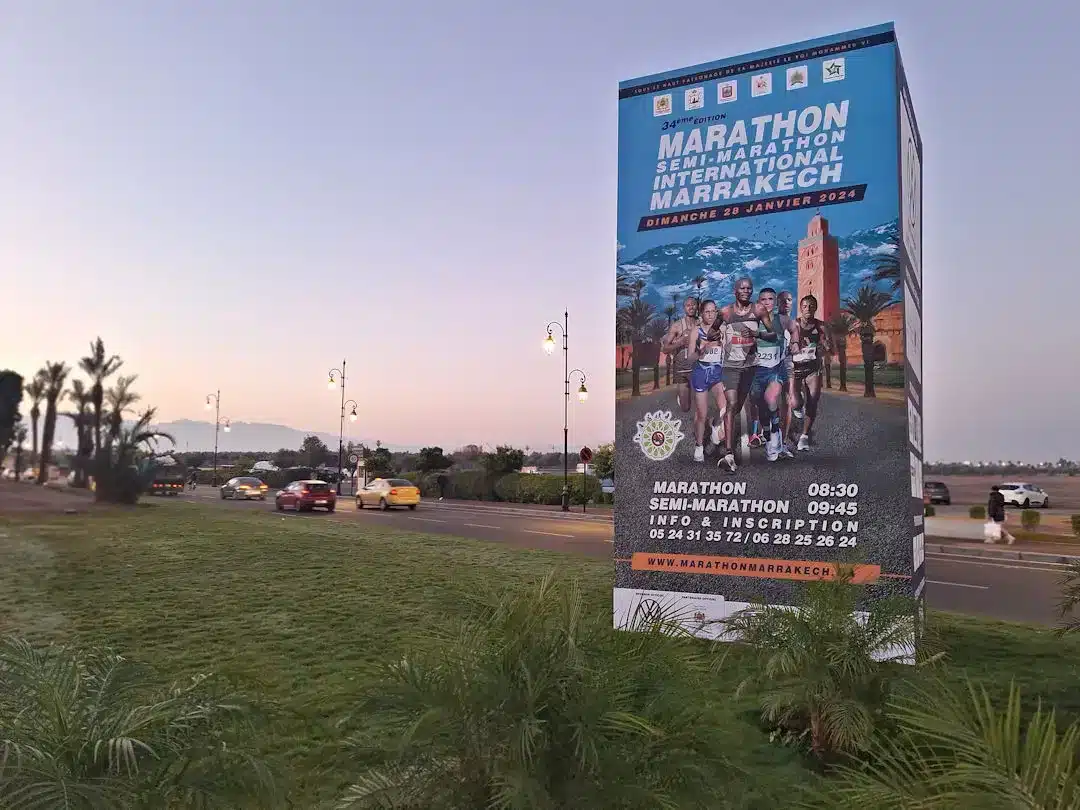
In January 2025, the Marathon International de Marrakech will celebrate its 35th edition
When is the next Marrakesh Marathon being held?
The next Marrakesh Marathon will be held on .
What is the weather like during the Marrakesh Marathon?
Being held in January, the temperatures are at their lowest for the region, as is the humidity. Dress for a cold start, knowing that there is a strong chance of it getting warm as the day progresses, especially if it’s forecast to be a sunny day.
| Year | Conditions | Low | High |
|---|---|---|---|
| 2024 | Sunny with some cloud cover | 4 | 24 |
| 2023 | Cloudy | 3 | 12 |
| 2020 | Cloudy | 5 | 15 |
| 2019 | Cloudy | 8 | 11 |
| 2018 | Cloudy | 2 | 13 |
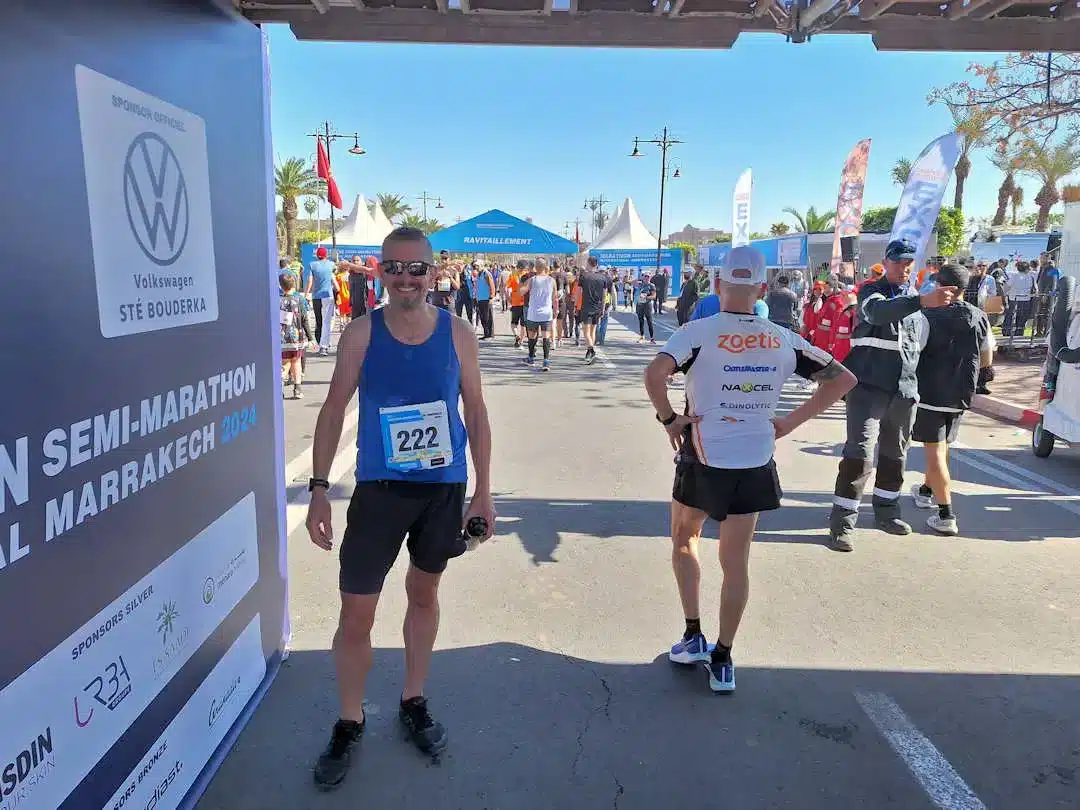
The temperature may only be single digit at the start of the marathon, but by the time you're finished, it will be boiling (or at least pleasantly warm)
How many people complete the Marrakesh Marathon each year?
Don’t be fooled by the number of entrants being bandied about. More than 16,000 runners from all around the world, as stated on World Marathons and Ahuto in the lead-up to the 2024 event, was nowhere near the number of people who actually attended. If you sum up the people attending the marathon event, the half-marathon AND the kids marathon, it still leaves you with about 7,000 runners short. Maybe they’re also counting the supporters? Who knows.
In reality, the Marrakech Marathon is a comparatively small race, with finishers hovering around the 1,000 mark. It’s most popular year was 2020, just before the COVID pandemic hit, and numbers seem to slowly build up again to that pre-COVID record:
| Year | Total | Male | Female |
|---|---|---|---|
| 2024 | 1,170 | 1,006 | 164 |
| 2023 | 838 | 740 | 98 |
| 2020 | 1,357 | 1,195 | 162 |
| 2019 | 1,150 | 959 | 191 |
| 2018 | 876 | 758 | 118 |
How many (foreign) athletes attend the Marrakesh Marathon?
While many other marathon events are able to produce this information easily, the quality of the data collected for this event is extremely poor.
Of the 1,170 marathon finishers in 2024, 333 were identified as overseas entrants, 349 were from Morocco, and a staggering 488 were not able to be identified by club, city or country. Assuming those unidentified ones are split in the same proportion as those that were identified, 49% of runners would be from overseas.
The event is heavily promoted by tour companies offering package deals, and this seems to be how a number of big running clubs from the United Kingdom, France, the Netherlands, and Morocco showed up at the start line.
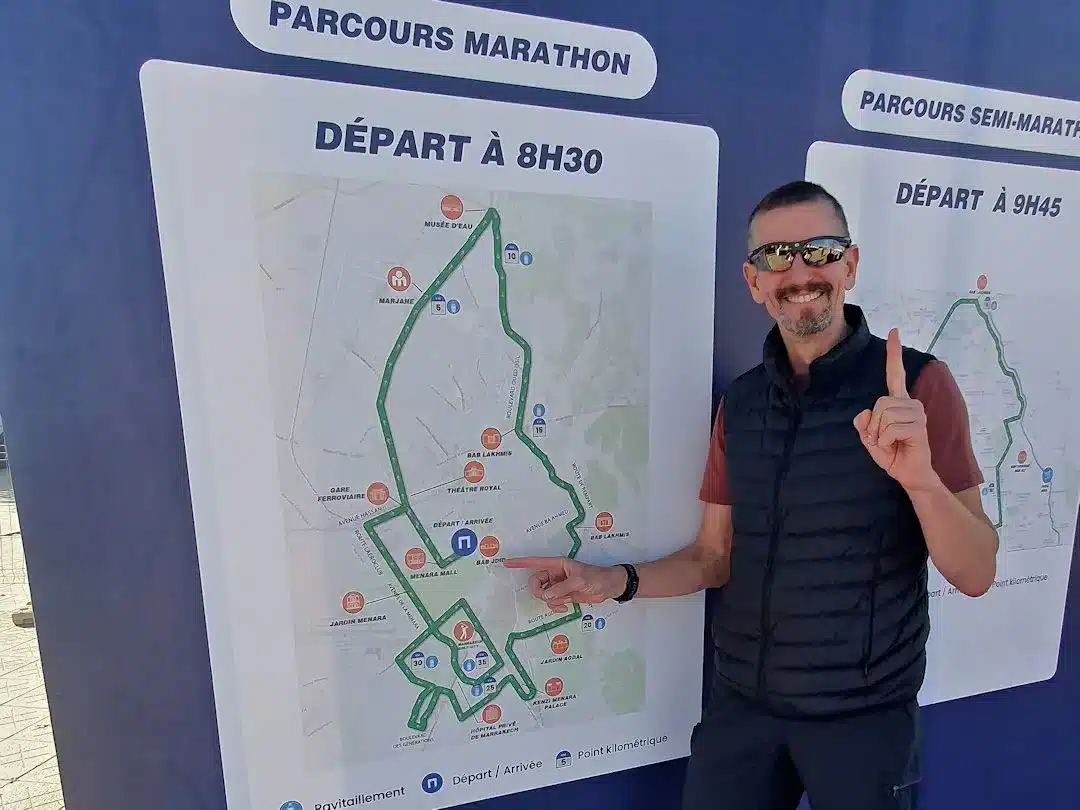
Be prepared for an adventure: Information about the Marrakesh Marathon was limited in the lead-up and not always correct
When and how to enter (and how much is the entry fee)?
The entry fee for non-resident international participants is EUR70.
Individual entry
Entries are accepted online via the official websites of the organization partners and in person on the days before the race at the race pack pickup location. There is no cut-off date and no early or late entry fee. It is entirely possible to arrive in Marrakesh on Saturday and attend the race on Sunday.
I entered the event in early December, completing the entry form online. The process was a bit archaic/antiquated: Since I was a foreigner outside of Morocco, I was required to send the entry payment to a bank account in the name of Mustapha BATIT. It seemed a bit dodgy, but we went ahead (transferring the entry fee via Wise), and I received an email confirmation of my entry.
Package tour
If you prefer someone else to organise your trip to the Marrakech Marathon for you, the official websites also offer tour packages (as do other travel agencies specializing in sports events). Marathon packages – quoted from EUR199 to EUR380 in 2025 – may include the following:
- 3 nights’ (4- or 5-Star) hotel accommodation (double or shared twin) including breakfast;
- Airport transfers to and from the hotel;
- City tour;
- Race Entry Fee;
- Delivery of your race number to your hotel;
- A short relaxing massage after the race.
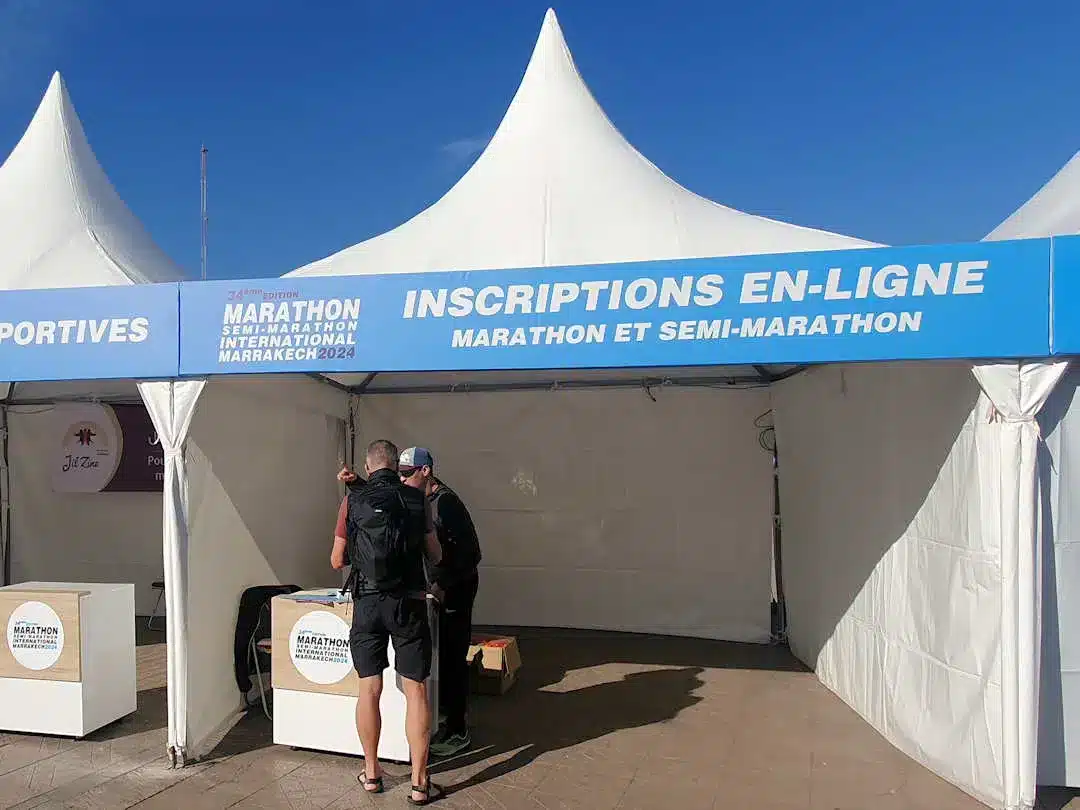
Without a cut-off date, early or late entry fee, you could enter the Marrakech Marathon (in person) on the Saturday and run it on the Sunday
What is pre-race communication like?
Apart from an email confirmation of receipt of entry, there is no pre-race email communication, and there is no online list to check your entry. There are no updates on the official website(s), only the occasional Facebook post on the official Facebook page (in French only). I even emailed the event organisers some questions, but I never received a response.
Where to pick up your race pack (and what to expect)?
The race pack pickup location is a collection of tents dotted around the fountain at Place du 16 Novembre. The signage is only in French. When we attended on the Saturday, there were no queues at all.
It is not immediately obvious where to pick up your race pack, so you may have to ask. Marathon participants receive a small carry bag containing a screen-printed, low-quality t-shirt, a race number (with a disposable RF timing chip on the rear – no need to return it after the race) and safety pins.
There is a tent for late entries, but there is none for general inquiries. Nor is there a Sports Expo normally associated with a large marathon. Communication is also made difficult by the fact that volunteer staff at race pack pickup speak hardly any English (and loud music blares across the square).
At least in 2024, the stage had a large advertising board where you could take some nice pre-race photos.
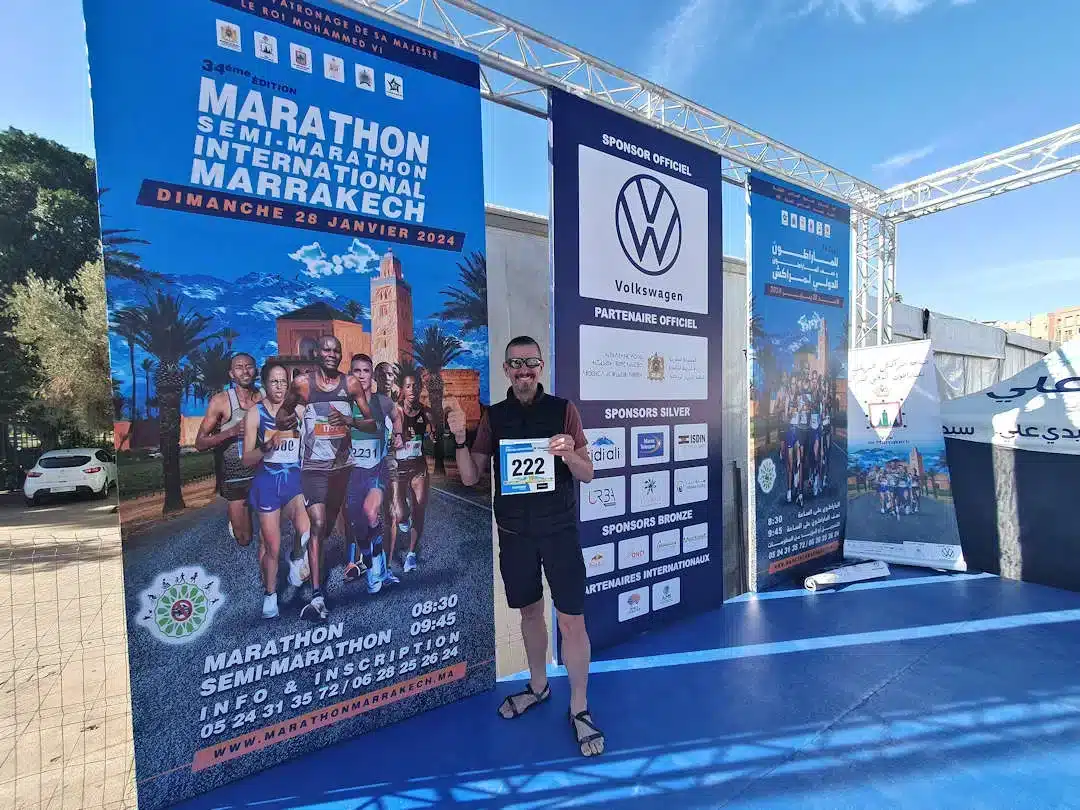
The Marrakech Marathon may not have a Sports Expo, but this nice little spot to take pre-race photos
What is the schedule of events leading up to and on the day?
| Time and Date | Event |
|---|---|
| 1000h to 1800h Friday 24 January 2025 and Saturday 25 January 2025 | Race Pack Pick Up |
| 0830h Sunday 26 January 2025 | Marathon Race Start |
| Until 1400h Sunday 26 January 2025 | Marathon Race Route Finish |
What do Marrakech Marathon finishers receive?
In 2024, all finishers received a medal. There are also awards for those placed first to sixth in each age group.
You also have the opportunity to purchase a photo from the official photographer. Tough, I found only two of me. There is no information on the official website/s about the event photographer.
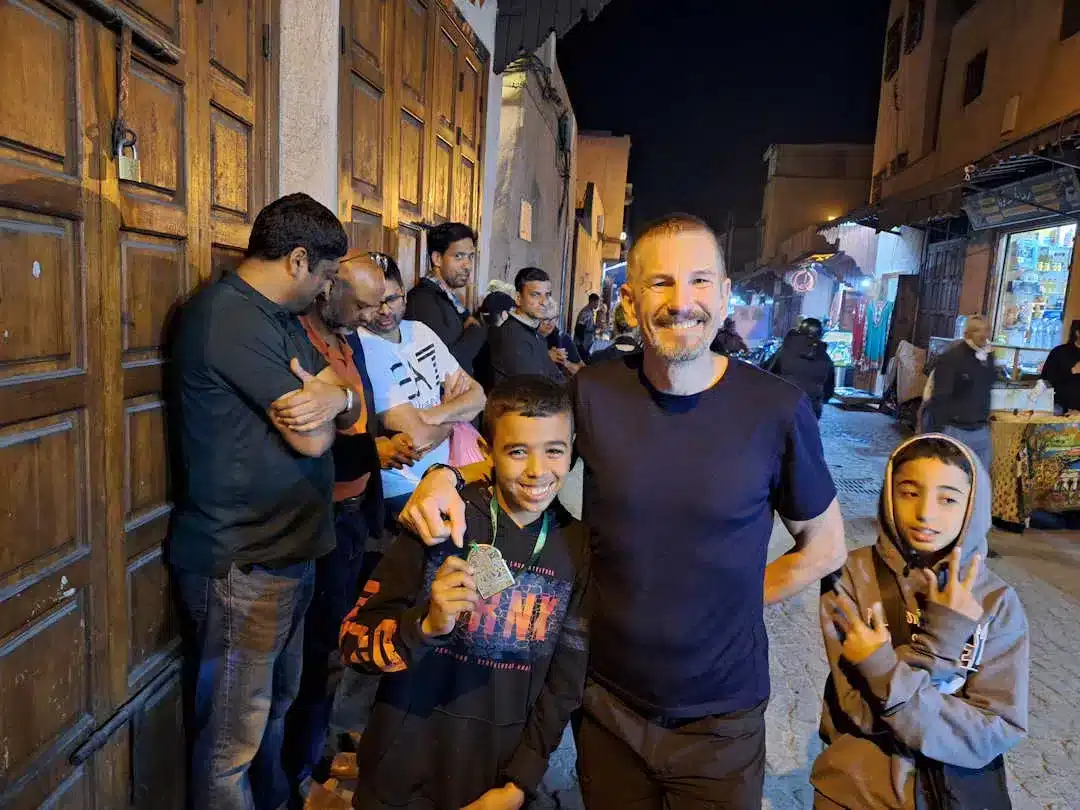
Marathon finishers receive a medal. Travelling with carry-on luggage only, Paul gave his away to a kid (who was super-stoked).
When and where are the Marrakech Marathon race results published?
Race results are published on the Marrakesh Marathon website [2023 results can be found here]. The race timing services are provided by Racetimer, a Swedish company with an office in Morocco.
In 2024, even though I ran the Marathon, my certificate contains a picture of the half-marathon route. What an oversight…
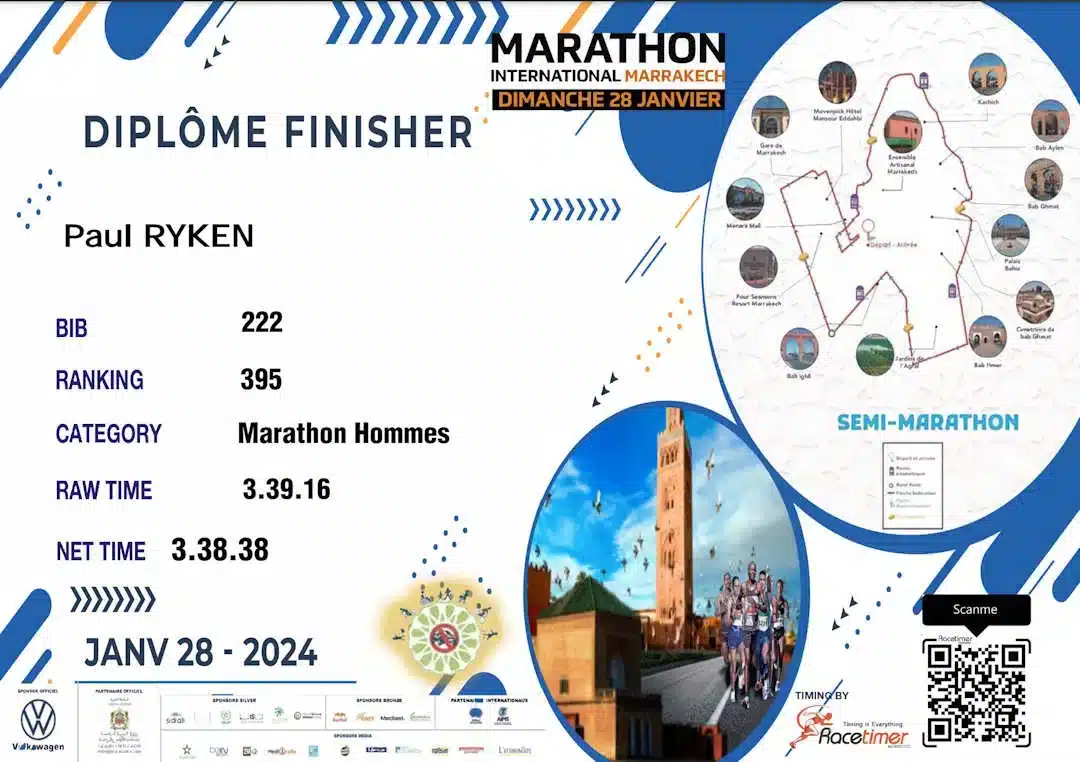
This is what the 2024 finisher's certificate looked like. Hopefully, by 2025, the incorrect route map has been fixed.
In 2024, organisers also displayed age group results. These were fairly meaningless though, as many participants do not have their date of birth or age group recorded. The age groups for the awards are as follows:
| Age | Male | Female |
|---|---|---|
| Open | Under 50 | Under 44 |
| Veteran | 50 and over | 45 and over |
Everything you need to know about the Marrakech Marathon Course
Below is the route map for the marathon, as well as recommended accommodation, points of interest, transportation hubs and eateries and food stores.
Key locations enroute
The first 15 km of the course lead through busy suburbs along major boulevards, first heading northeast to and then south from the Water Museum. Between kilometres 15 and 19, the course traces the outside of the medina and passes a number of gates into the Old Town (called bab) before turning west to pass through Agdal Gardens (which also marks the halfway point).
The key locations of the route are below:
| Name | Distance |
|---|---|
| Royal Theatre and Gare Ferroviaire/Marrakech Train Station | ~2km |
| Musee D'Eau/Water Museum | ~9km |
| Bab Kechich | ~15km |
| Bab Debbagh-Kawtar | ~16km |
| Bab Ghmat | ~18km |
| Bab Ahmar | ~19km |
| Agdal Gardens | ~21km |
| Menara Gardens | ~37km |
Marrakech Marathon Course Description
The first 9 km of the route are downhill (50 metre drop in elevation) heading in a northeasterly direction. From there, it climbs gradually until it reaches 23 km (88 meters in elevation). From 23 to 33 km, there are some undulations, but they are barely noticeable. From 34 to 40 km, there is a slight downhill, again barely noticeable. The final 2 km are again slightly uphill.
You’ll have the sun in your eyes a lot, so wear sunglasses (and sunscreen).

The Marrakech Marathon course is undulating, with an initial decline and a final (though barely noticeable) incline
The route has been approved by an international official expert at IAAF, IAAF being the former name of World Athletics (until 2019). The organizers also claim that the event complies with certain criteria in order to be considered eligible for top lists, entry standards, world rankings, and world records. That said, there is no record or mention that the event complies with World Athletics rules, and no valid International Course Measurement Certificate has been sighted.
Learning from previous years (when some runners went off-course as directions weren’t clear), in 2024, there was at least one course marshal whenever there was a left or right turn. In addition, there were large stickers on the road (although some had been destroyed by cars driving over them, specifically at roundabouts).
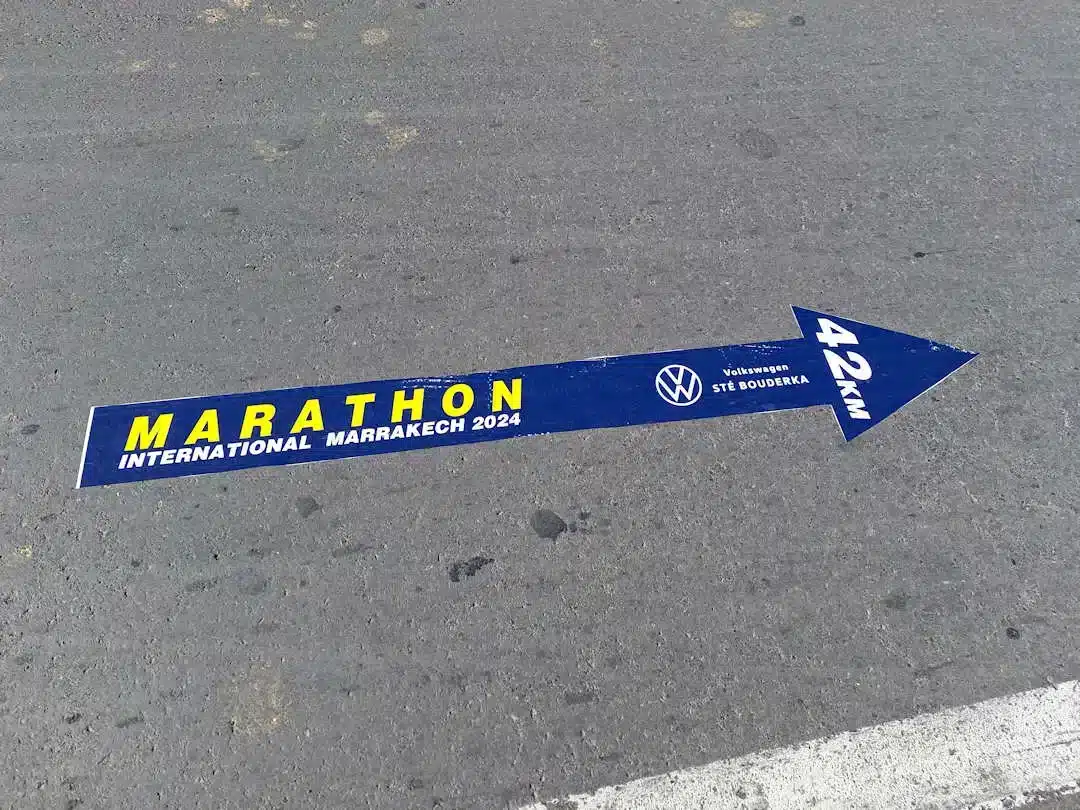
Course marshals and large stickers on the road made sure that no one would get lost (unlike in prior years)
While there are always the Atlas Mountains to the south and east to keep you company (at least on a clear day), from the 21 km mark onwards, there is not really much to look at, as the course meanders through suburbia, through new developments, past construction sites, open fields, shops, and the occasional small park.
Course entertainment and spectators
There was live entertainment at various parts of the route. The spectator crowd was small, mostly concentrated around the aid stations (and thinning out the further one got from the city centre). The largest crowd was concentrated around Menara Gardens, where the marathon course and the half-marathon course joined.
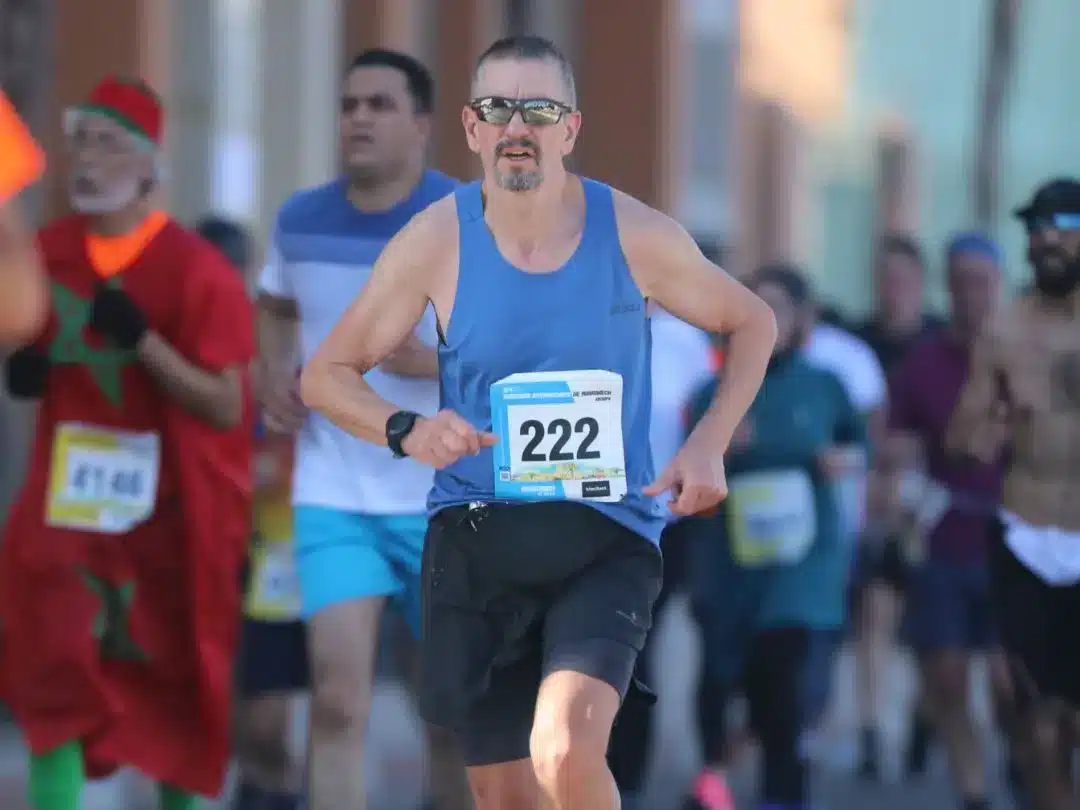
Official photographs can be purchased after the event, though don't count on it (there were only two of me for the entire race)
Traffic management
For the most part, runners had a dedicated lane which was closed to vehicular traffic – except at major roundabouts. At those roundabouts, cars were allowed to pass through between athletes, as directed by police. That said, drivers in Marrakech are some of the worst we have ever experienced, and they do not necessarily slow down when approaching a roundabout (even one with a waving policeman). Road cones placed incorrectly also did not contribute to the safety of participants (or provide clear directions for drivers).
In 2024, many Marrakesh residents were not aware of the marathon being on, despite major signage on display in the lead-up to the event. Apparently, the city had also made the day “Leave your car at home day”. Clearly, the messages didn’t get through.
A major bottleneck occurred around Menara Gardens, where the marathon and half-marathon courses joined. Cars were allowed to travel in one lane (west to east on Avenue Guemassa), while the east-west lane was closed to participants. Cars were stopped (intermittently) at the intersection of Avenue Guemassa and Boulevard Mohamed VI. Drivers were honking as they had no idea why they were stuck in traffic. Athletes had to run past exhaust fumes of hundreds of cars queued up on that intersection alone.
Queues of cars also built up in the Menara Gardens along Boulevard Mohamed VI (coming from the north) with nowhere to go as the intersection in front of them was closed off for them completely.
If this sounds like chaos, it is. Much better traffic management is definitely needed.
Anna K on Racecheck said that she had done a lot of marathons in her time, and they had all been very different. Because she was slow, just ducking in under the cut-off time, the roads seemed to have opened again, leaving her at times to negotiate 8 lanes of traffic, and nearly getting lost because the local public servants who were sorting the traffic, had disappeared.
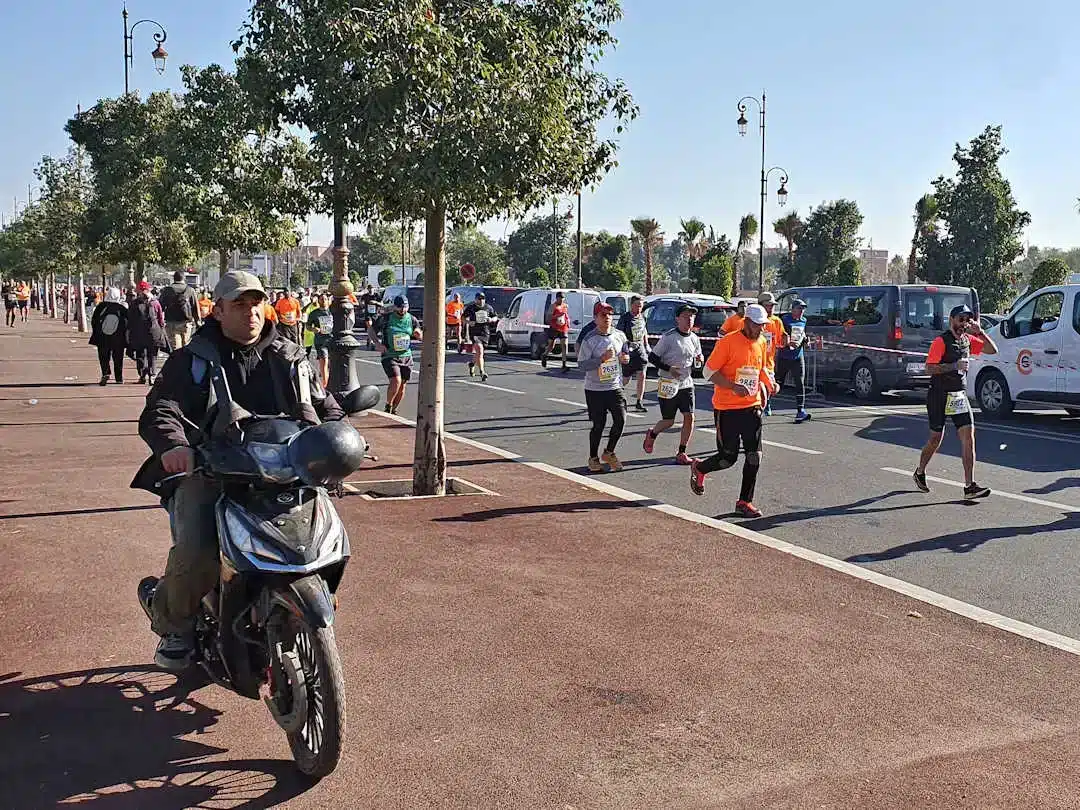
Traffic management was haphazardous, with the worst congestion occurring at 36kms when marathoners and half-marathoners joined (among cars stuck in traffic)
What is supplied on the course?
Route/distance marking and timing equipment
Official timing was performed using standard RF-ID timing transponders. Timing mats or frames were located at the following locations:
- Start/Finish Line
- 10km
- 20km
- 27.5km
- 31km
- 37.5km.
These are indicated on the map above.
Pace guides
The Marrakech Marathon has no pacing guides.
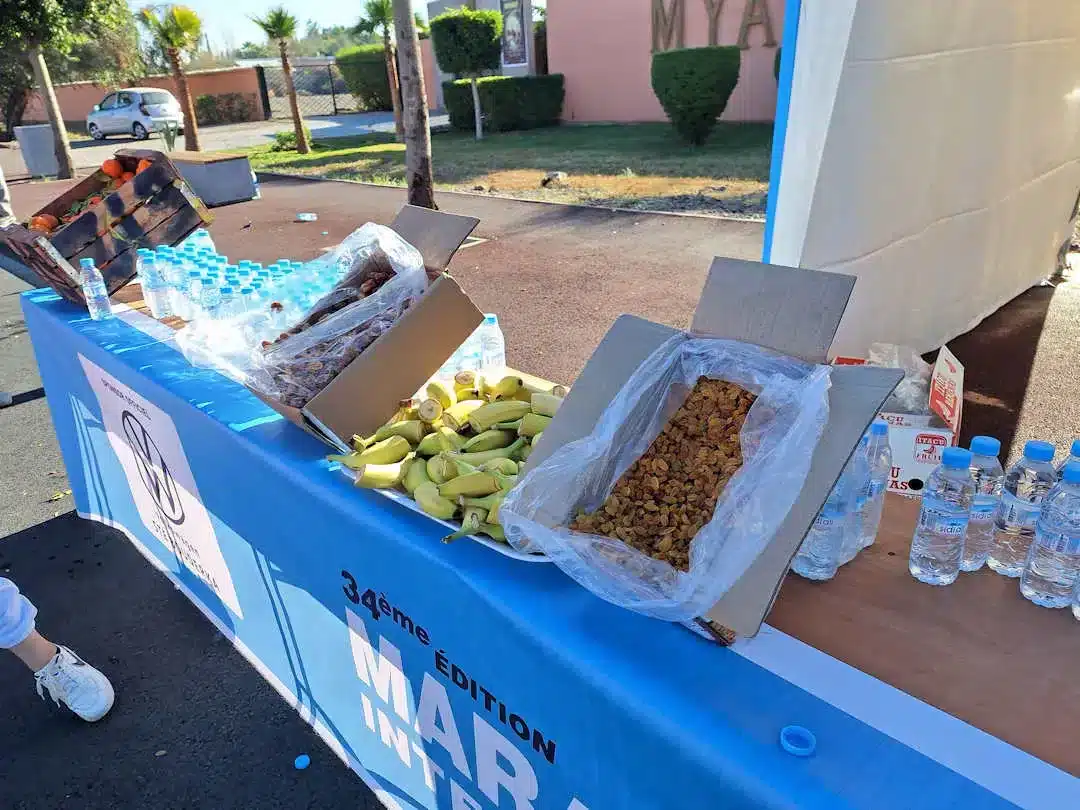
From 15km, support stations provided not only water but also oranges, dates, bananas and raisins
Support Stations
In 2024, there was no information on the official website(s) about the locations of the support stations. Fortunately, a large display map at the race pack pickup showed that there would be support stations at 5 km, 10 km, 15 km, 20 km, 25 km, 30 km and 35 km. On the actual course, there was also a support station at 40 km. Information on the website(s) was also very limited when it came to what the support stations would provide, including whether there would be any special drinks for non-elite/invited runners, such as electrolyte drinks. One website stated that support stations would only provide water and orange sections.
During the race, bottled water was provided at each support station. Bananas, dates, raisins and oranges were provided from the 15 km support station onwards. At some support stations, the bananas were cut in half. And at some support stations, the officials removed the caps from the water bottles. Unfortunately, support station tables were quite bunched together. Thus, runners had to slow down considerably or stop to take what they needed.
Keen to run a marathon in Japan? Could Nagano Marathon be an option?
Are you keen to run the Nagano Marathon but don’t know what to expect? Here is my detailed review and all the information you need to attend the event in 2025.

Small green signs with a red star indicated each support station about 150 metres in advance
Small signs indicated each support station about 150 metres in advance. There were times when the water tables were first, whereas (at least in my opinion) water tables should always be last. One positive was that the bottles and trash from the support stations were being picked up promptly by city officials (not volunteers).
First Aid
Ambulances moved back and forth along the route (as much as they could among the road closures and traffic jams).
Registration and event database quality have massive medical and support implications if not done right. It can compromise the health of the participants and others. If first aid is required, and the runner is unidentified through a database anomaly, medical workers will have no context for the person they are treating, since they don’t have their name, emergency contact or medical information recorded.
Toilets
No information was provided about toilets on the course. There were a number of porta-loos at the start/finish area, and I did see one porta-loo at one support station, but I didn’t notice any other.
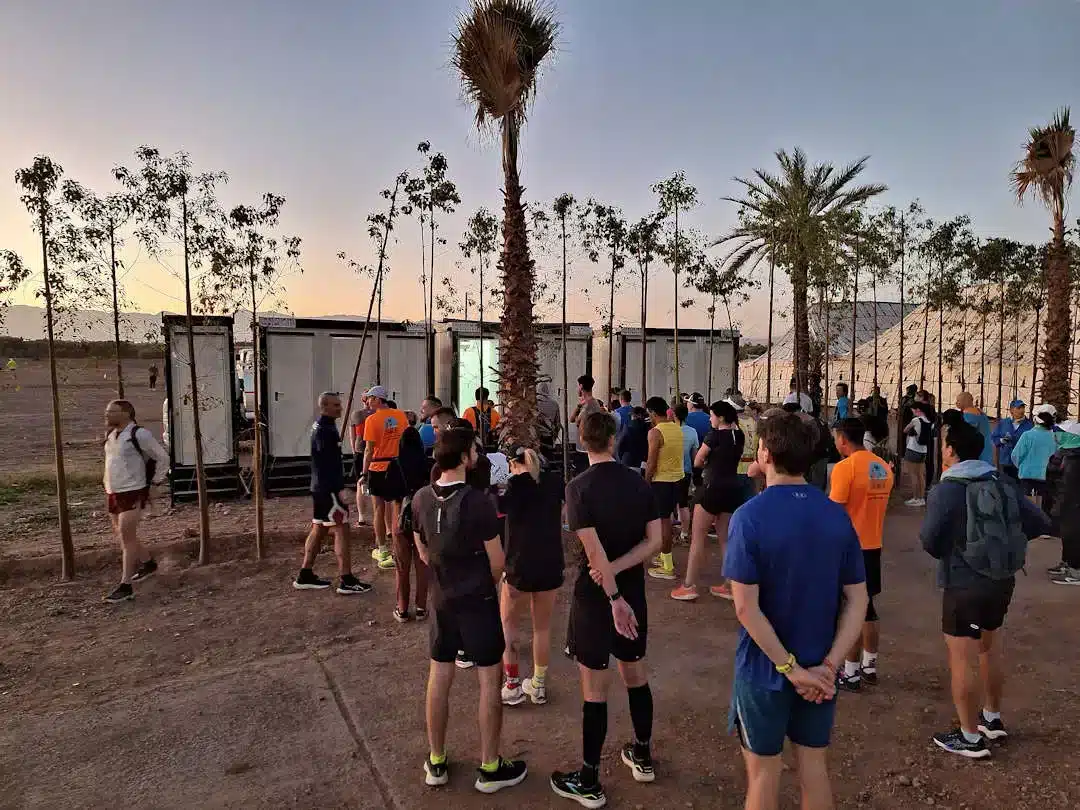
Make sure you go to the bathroom before the race - there aren't many other options on the Marathon course
What is it like to run the Marrakech Marathon?
Marrakesh Marathon - Race Report and Review
Overall
-
Course Difficulty (1 = Difficult, 5 = Easy)
(4)
-
Course Scenery
(2)
-
Organisation
(1)
-
Spectators
(2)
-
Timing Points
(2)
-
Support Stations
(4)
-
Value for Money
(4)
My personal race experience
Start
The start was relatively orderly, with drones buzzing overhead taking photos and many different languages being spoken. Despite that, all loudspeaker announcements were (only) in French. The field spread out pretty quickly. My pacing strategy was to use a custom Garmin Workout to keep my pace between 4m50s and 5m00s per kilometre. For the entire race. Nothing more complicated than that.
With the sunrise occurring at the same time the race started (8:30), the temperature at the start was only 9 (officially 4) degrees Celsius. Wearing only my singlet turned out to be insufficient – at least for the first 5km. In hindsight, I should have worn the official t-shirt on top of my singlet and disposed of it once I’d warmed up.
10km
Few people were out on the route to cheer us on. Occasionally, a cluster of people would appear at intersections or entertainers would play music and dance. Our footsteps made the most noise. Short conversations between runners broke the initial monotony. The 5km support station with the bottled water was barely noticed or used.
Heading out of the city northwards, largely shaded by buildings, we took a sharp right turn at about 9.5km, exposing us fully to the rising sun as we headed south. I ran the 10km in 48m19s. Slightly faster than I wanted (but hopefully not too fast) and on target for a sub-3h30m marathon.
20km
As the sun continued to rise, so was the temperature. When I finished, it was 24 degrees Celsius/75 degrees Fahrenheit, but for now, it was just pleasant. After we had passed the walls of the Medina, the course became less attractive: new subdivisions, light commercial areas, palm trees, occasional gardens.
The road surface was generally good: the roads were wide, and the camber was light. It was easy to just roll through and let the kilometres tick over, minimising the effort by running the tangents from the curb to the centre of the road. I reached the 20km mark in 1h36m50s. Still on my sub-3h30m schedule. I felt good at this stage. I was drinking at every support station and by now, bananas were being offered.
30km
As the morning wore on, more people were out supporting the event, and more traffic was building up at the periphery. At times, cars and scooters appeared on the marathon route, but the roads were still wide enough to accommodate both – the occasional vehicle and us strung-out runners. Roundabouts though started to become bottlenecks: some drivers were impatient or frustrated having to wait, leading to some erratic moves and causing concerns for the safety of us athletes.
At 26km, I had stopped at a palm tree for a quick pee. I hadn’t seen a portable toilet at the previous support station. I was still feeling pretty good at 30km which passed in 2h26m07s – slowing ever so slightly with an estimated finish time of 3h25m.
40km
The next 10km were brutal. And I had not seen it coming, given the amount of training I’d done and my experience running 30+ marathons.
I always vow not to walk during a marathon. But for some reason, my resolve was quick to fail me (and as early as 32km). I reasoned with myself to walk 2 lamp posts and run 10, and this was my MO pretty much for the rest of the race. I was hurting and tired (as expected), but I wasn’t in pain. It doesn’t seem logical now.
I always knew I would finish, and by this stage, I’d stopped checking my watch to stay on target. I should have. The effort I’d put in at the beginning was being negated by my lack of self-drive and will power. The 40km couldn’t come soon enough: 3h25m29s was meant to be my finish time. But I still had 2km to go.
Finish
I managed to pick myself up and run the last 2km. Coming around the corner with barely 500m to go was a relief. I cleaned the snot off my face, turned my smile on, not knowing where the official photographer/s would be (were there any?). I turned my large bum bag around and got my phone out. I knew I hadn’t achieved my goal time, so was happy to lose a few more seconds to take some photos of the finish line as I approached it.
Crossing the finish line in 3h38m32s, I was happy to finish, but annoyed at my lack of will power.
After the finish line
The finish area was bulging with half-marathon runners at the time I finished at 12:09 (so 2h24m into the half-marathon), despite there being a separate finish line for each.
I was handed a medal and a small goodie bag containing a bottle of water, a banana and some raisins. There were no maps of the finish area – so again, it was impossible to know what was available (toilets, massage/first aid tent, information booth, lost runners/family reunion area, etc). Sandra took a few photos, and my Africa marathon was ticked off.
Given our accommodation was only 1.7km from the finish line, I decided to hobble back slowly. For the rest of the afternoon, I slept, hydrated slowly and recovered. So much so that I was able to join a Street Food Walking Tour the following evening.
Results
My goal time prior to starting was 3h30m, and I finished in 3h38m with an average pace of 5m11s per kilometre. I finished 395th out of 1,170 finishers – see the official results and Strava.
Given my personal details were not in the database, only my race number (222) was initially searchable. I informed the organisers – actually sending the email to four different email addresses, as (like the website/s) it was difficult to know which one was the correct one for the event organisers. Although I was told I may need to wait up to a week to see my name, it appeared a few days later. I then had to email again, asking for my country and date of birth to be included. My results now show my name, my city (not country) and my age group results, but half the timing location data is incorrect. All in all a very poor experience.
Pros
- A good number of support stations
- Course volunteers were friendly
- Good entertainment on route
- Wide roads
Cons
- Much hype not backed up by reality
- Lack of communication (especially to independent travellers)
- Lack of information on the website(s)
- Slow or no response to email communications
- No start / finish venue maps
- No bag drop
- No pacers
- Very limited official photos
- Chaotic finish area
- The medal was the same for marathon and half-marathon
Would I recommend the Marrakech Marathon?
As you can tell from my report, the Marrakech Marathon was certainly an experience I won’t forget. Despite the hype and the fact that on the day things may turn out better than expected, I wouldn’t recommend running the Marrakesh Marathon as your first marathon experience. There are better organized marathons out there to complete as your first.
If it’s not your first and/or you like a challenge, and you are relatively self-sufficient (even better: you speak French), the Marrakesh Marathon is a good marathon to tick off your bucket list, especially now that you have this guide that provides (most of) the answers I didn’t have prior to mine. Running a marathon on the African continent with the backdrop of the snow-capped Atlas Mountains is pretty special (despite all the shortcomings).
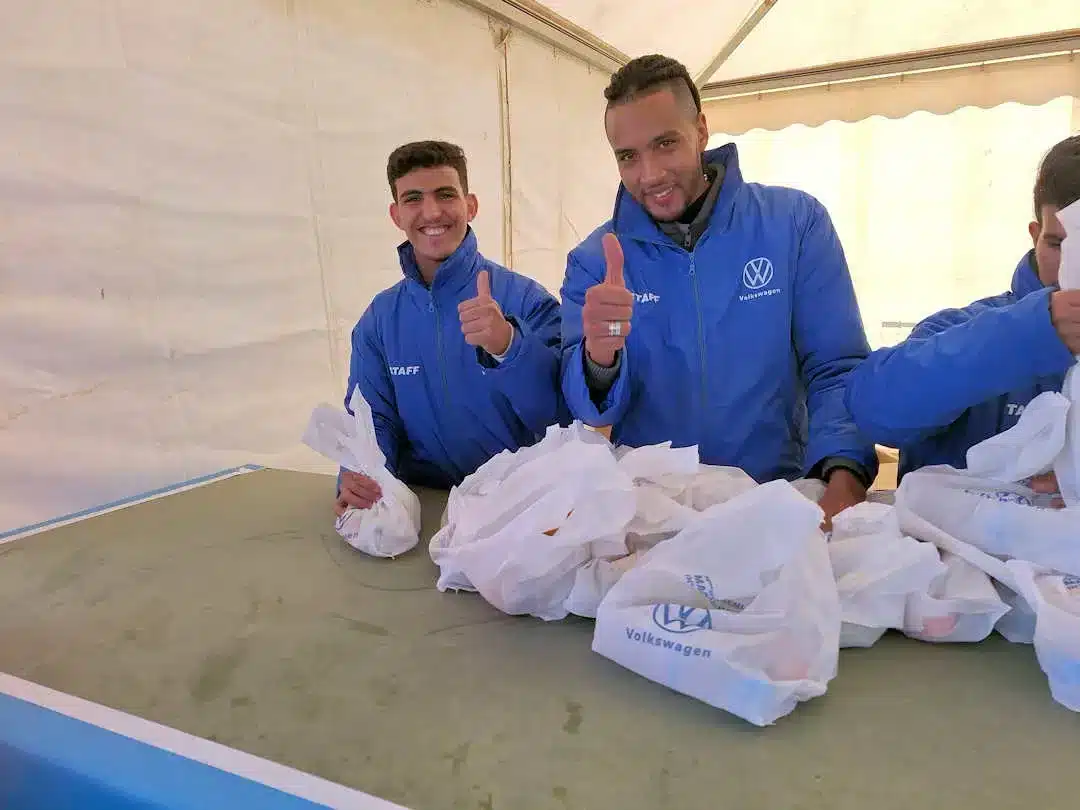
The volunteers are all friendly, but if it's your first marathon, choose a better organised one (and run Marrakech another time)
How to get to Marrakech?
By Air
As overseas entrants and supporters, you are likely to enter Marrakech via aeroplane. The closest airport is Marrakesh Menara Airport (Google Map Location, IATA: RAK), named after the suburb it is located in, with daily direct flights from and to various cities in Morocco, Europe, and North America.
We travelled from New Zealand to Morocco, breaking up the journey with two stop-overs – in Singapore (for three nights) and London (for two nights). We arrived in Marrakesh 8 days prior to the event so as to acclimatise and ensure no feelings of jetlag from the long trip remained. Thanks to those lengthy stopovers, we had no jetlag whatsoever, and (in hindsight) could have arrived on the Friday before the race.
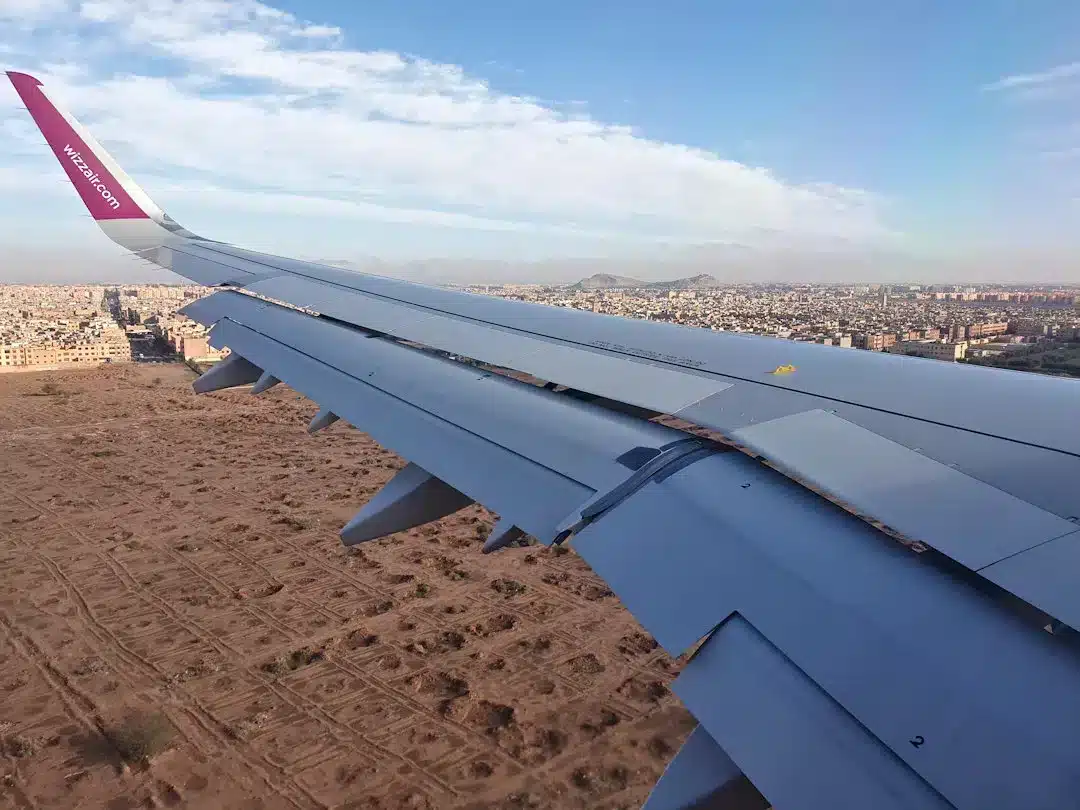
Marrakech Menara Airport is located 5 km from the city centre (as the crow flies), and as such, it’s easy to get to your accommodation from there. Options include the following:
Public ALSA buses L11/L12/L18/L20/L33
These public transit buses leave from the bus stop on Avenue Guemassa [Google Maps location], a 700metre/10 minute walk outside the Airport Terminal (turn left at the roundabout and cross the road if you want to head into the city), and cost MAD4 per person. Use Google Maps to look up the best connection for your destination.
ALSA Airport Shuttle Bus L19
The shuttle bus leaves from the parking lot just outside the airport terminal and takes passengers to the Marrakech train station [Google Maps location] and Jemaa El Fna [Google Maps location] (with interim stops near key hotels) for MAD30 per adult. You can return on the same ticket if your return flight is within two weeks.
Once you have withdrawn or changed currency (in the Airport Departures Hall), walk back to Arrivals, head outside, cross the road, and go up the few steps to the parking lot. The bus is clearly labelled all around. Payment of the fare is in cash on the bus.
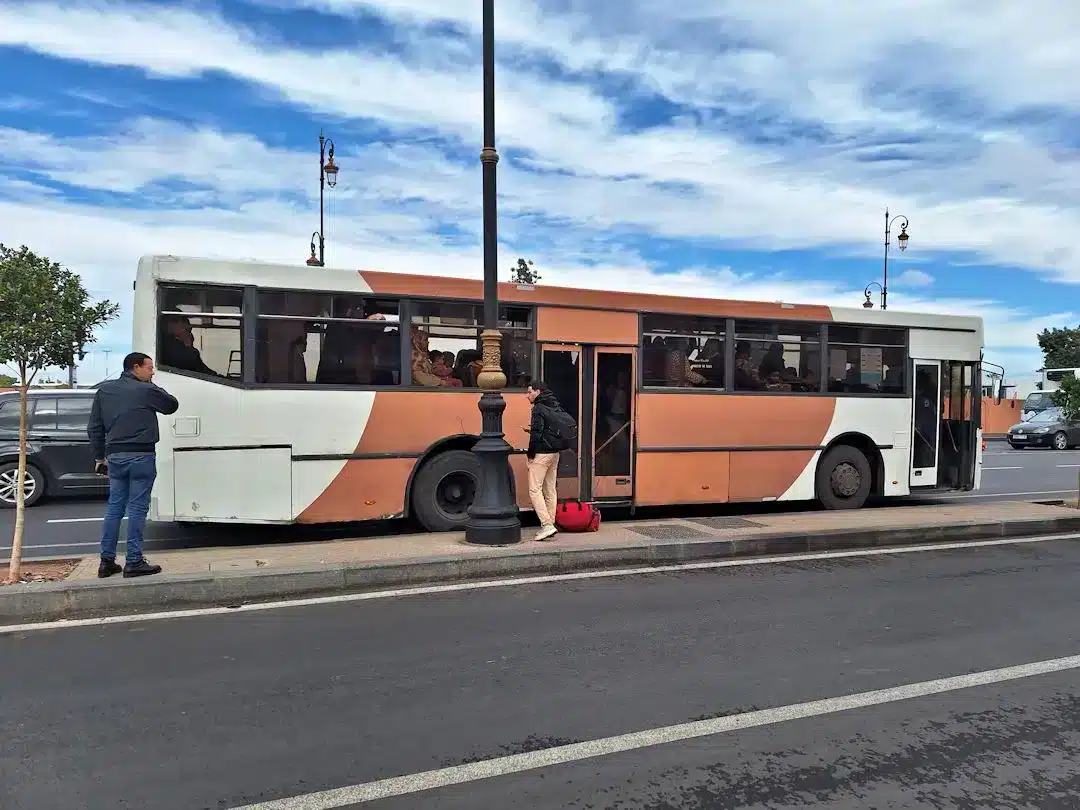
From the airport, you can take the convenient ALSA Airport Shuttle (L19) or public ALSA Buses like the one above (L11/L12/L18/L20/L33)
Taxis
If you prefer the convenience of a taxi, head to the kech.cab taxi order counter at the Arrivals exit. You prepay your fare based on your destination by card or in cash (the price is fixed) and will receive a taxi ticket with a QR code. You then head outside, walk up to the taxi rank and scan your taxi ticket at one of the machines. Don’t forget to obtain the ticket dispensed by the machine—that’s the ticket you need to give to the dispatcher who will locate your taxi for you.
I know, it all sounds a bit complicated (but it’s a million times better than haggling after a long flight).
If you want to use the service in reverse, you can also book your taxi online.
My Minimalist Travel Running Gear: Your Essential Guide
If you are a frequent traveller and fond of running and can never afford to miss it, then always make sure to carry your running gear every time you travel.
I research and document every item that I carry as a location-independent runner, whether during van life, in our backpacks or as a digital nomad. My packing list is based on my own experience. If you travel (and who doesn't) and like to go for frequent runs on your trips and have something to add as recommendations for the items to carry, please feel free to contact me.
If you liked my packing list and found it helpful, I would appreciate it if you could share it with your friends and family via the Share buttons below. Even better, link to the page from your personal blog or social media platforms.
By Train or Bus
If you combine the Marrakech Marathon with a longer trip around Morocco, you may also arrive by train or bus.
Marrakech’s ONCF Train Station [Google Maps location] is located at the roundabout of Blvd Mohamed VI and Av Hassan II (diagonally across from the Royal Theatre). The ALSA Airport Shuttle Bus L19 stops right outside the station, and public ALSA buses also stop in walking distance (just use Google Maps to look up the best connection for your destination). If you want to take a taxi from the train station, be prepared to negotiate the fare with the driver.
The two bus companies we have used and can recommend in Morocco (among several others) are Supratours and CTM. The Supratours Bus Terminal is located on the side of the Train Station on Av Hassan II (Supratours is part of ONCF). The CTM Terminal is located only a few minutes’ further at the intersection of Rue Abou Bakr Seddiq and Rue Zïneb Nafzia (about 800 m or a 10-minute walk).
Bus or train tickets can be booked online.
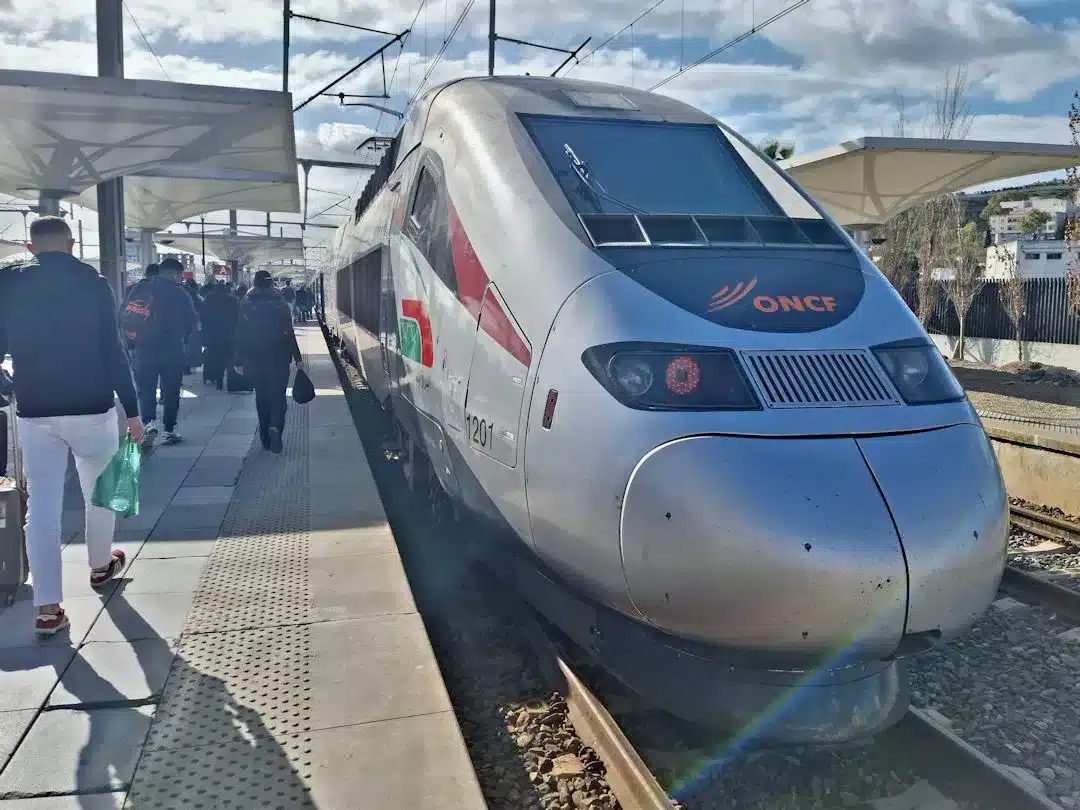
Coming from Casablanca, Rabat, Tanger or Fes, you can also travel to Marrakech by train - this Al Boraq between Tanger and Casablanca reached 315km/h.
Where to stay for the Marrakesh Marathon?
With potential road closures (and the mayhem traffic) on marathon day, you’d want to eliminate use of any form of transportation. We therefore recommend choosing accommodation in walking distance from the start/finish area – in either the Hivernage or Sidi Mimoun areas. The city centre is flat, so walking 1-2km to the marathon is easy (and not a bad idea afterwards either to prevent you from stiffening up). Our recommendations for accommodation near the Marrakech Marathon start/finish are (in order of walking distance):
| Name | Property Features | Price Indicator | Book Now |
|---|---|---|---|
| Barthelemy Guest House | 800m from Marrakesh Marathon start/finish Beautifully decorated guesthouse in the Hivernage Year-round outdoor pool Continental breakfast available Non-smoking rooms Close to Marrakesh Train Station | $ | Book Now |
| Chez Jerome et Pamela | Breakfast included | $$ | Book Now |
| Dar Othman | Recently renovated Riad Shared kitchen, lounge and terrace | $ | Book Now |
| Hotel and Riad Veridis | Non-smoking rooms On-site restaurant | $$$ | Book Now |
| Othmane Apartment | Walking distance to Marrakesh Airport | $ | Book Now |
| Riad Al Uzza | Certain documented environmental practices implemented at property. Non-smoking rooms 24-hour front desk On-site restaurant Indoor pool | $$$ | Book Now |
| Riad Anya and Spa | 1700m from Marrakesh Marathon start/finish 4-stars Swimming pool in the patio and a hot tub on the terrace Restaurant Non-smoking rooms | $ | Book Now |
| Riad Beni Sidel | 1800m from Marrakesh Marathon start/finish Indoor swimming pool Non-smoking rooms | $ | Book Now |
| Riad Dar Naomi | Non-smoking rooms 24-hour front desk On-site restaurant Indoor pool | $$ | Book Now |
| Riad Hilmuna | Certain documented environmental practices implemented at property. Non-smoking rooms 24-hour front desk On-site restaurant Indoor pool | $$ | Book Now |
| Riad Maialou and Spa | Certain documented environmental practices implemented at property. Non-smoking rooms 24-hour front desk On-site restaurant Spa and wellness center | $$ | Book Now |
Some properties in walking distance to the start/finish line are already booked out on the Marathon weekend, so get in there as soon as possible to avoid disappointment.
What we did
We stayed in a nice little Riad in Sidi Mimoun, around the corner from the latter two on our recommendations list. Unlike Hivernage, Sidi Mimoun is not at all touristy but an area where local families live. Some older buildings have crumbled in the September 2023 earthquake, so it’s not the prettiest area at first glance. But, it’s safe (the Royal Palace next door is guarded day and night) and super quiet.

The Sidi Mimoun neighbourhood near Bab Agnaou is a great location for those wanting to stay in walking distance to the Marathon start/finish line
How to go about supporting a participant?
If you want to support an athlete along the route, the best options to travel are by bicycle or walking. If you stay in Sidi Mimoun, Marrakech Green Wheels is your closest bike rental shop. For reasons mentioned throughout this article, it is not recommended to use a hire car to move between locations on the route. Using public transit is also not recommended for the same reasons.
What we did
After sending me off at the start line, Sandra met me at 22 km, 37 km and again at the Finish. Including the walk to/from the start/finish line, she walked about 13 km. With the benefit of hindsight, she would have hired a bicycle (as she did when she supported me during the Nagano Marathon.
As for us runners, it was initially incredibly cold for her, and as the day progressed, she peeled off the layers. Make sure to put on sun screen (or at least apply it as soon as the sun rises).
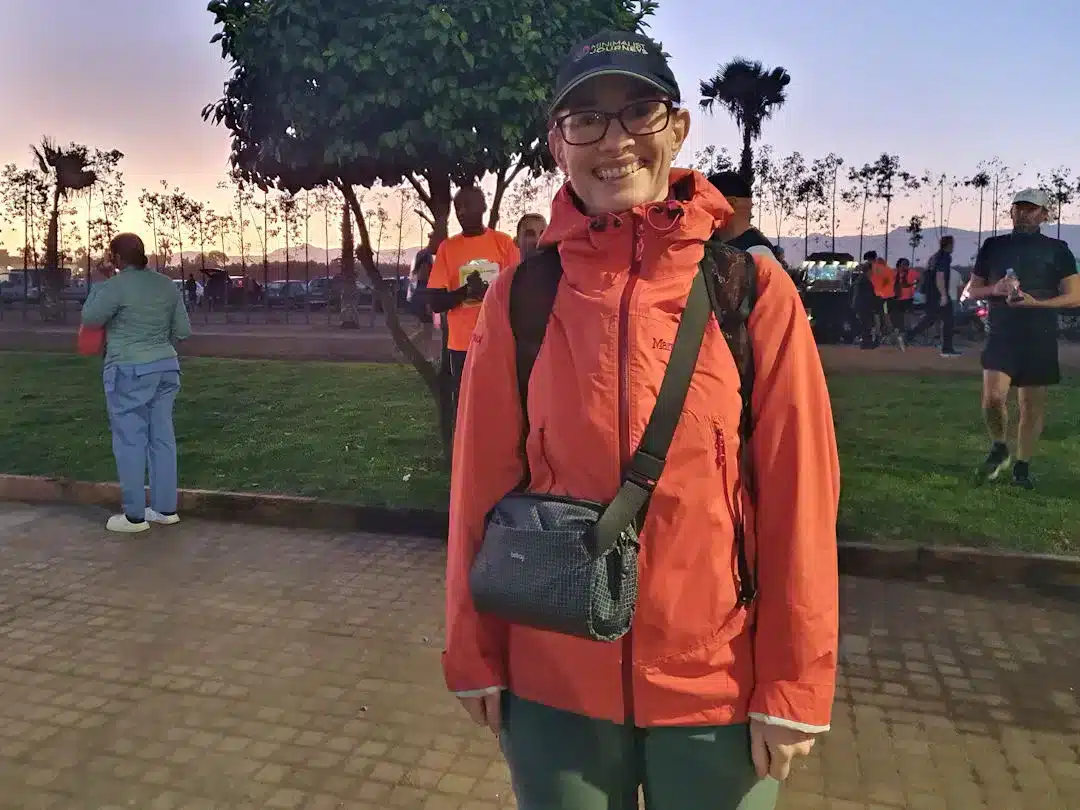
Wearing layers is even more important for your support crew, as it starts bitterly cold and warms up as the sun rises
Public or event toilets were few and far between. Don’t rely on using porta-loos for runners on the route. She didn’t actually see any where she was passing. Almost busting, she found a (normal) toilet near the Carrefour Express in the Marrakech Prestigia Shopping Village (marked in above map).
The point where the marathon and half-marathon routes join (at the intersection of Blvd Mohamed VI and Av Guemassa), it gets super-crowded. After meeting me at the 37 km mark (just after that intersection), she ended up running to the finish line herself to be back there in time to meet me again.
With the half-marathon and marathon routes splitting and rejoining again just before the finish line, she had to navigate around fences and barricades, somehow ending up in the finish chute among all the runners (no one stopped her). Under normal circumstances, I would have met her after receiving my medal and goodie bag (there was a barrier runners had to walk through into the post-finish area). But with her somehow sneaking through, she was only 20 metres in front of me as I ran across the finish line.

Sandra's final photo, just before I arrived - she somehow ended up in the finish chute
What to do in/around Marrakesh besides the marathon?
We started and finished our Morocco adventure in Marrakech, spending a total of 12 nights in the city. Here are our favourite things to see and do in/around Marrakech:
Here are some wellness treatments you may want to consider BEFORE your marathon:
- Hammam Semlalia or Hammam Nilo – for a more traditional hammam experience (you’ll have the top layer of your skin scrubbed off, but boy does it feel great afterwards);
- Massage at La Maison du Tui Na – that’s the one I went to. I’d contacted several massage services – first via email and then via WhatsApp – and eventually found this one. It wasn’t cheap but well worth it to get rid of some of the knots and help with some final stretching of the hip flexors. Unfortunately, I can’t remember the massage therapist’s name (it’s the name of a city, and she’s a physiotherapist – if that helps).
You can’t leave the city without some cultural experiences. After all, it’s Marrakech:
- Join a Free Walking Tour of Marrakech with Mustapha – great to get your bearings around the medina/old town, learn about this stunning city and hang out with a local.
- Visit the Musée MACMA/Moroccan Art Museum – a private collection celebrating the work of contemporary and historic Moroccan artists (from paintings and old photographs to sculptures and every day objects), the museum is open Monday to Saturday 1000h to 1900h. The entry fee is MAD70 per person.
- Explore the Ben Youssef Madrasa, a beautifully intricate, restored Islamic school with 136 rooms spread around multiple courtyards. Originally built in 1565, it was a (boarding) school for students from around the world for 400 (!) years.
- Join a traditional concert at the Musée de la Musique on Monday, Wednesday or Friday evening from 1800h to 1900h. Go to the museum first (to learn more about traditional Moroccan music and instruments) – it closes at 1800h. The price for the concert (including tea) is MAD100 per person. Book online in advance to not miss out.
- Learn how to make traditional Moroccan moccasins in this Babouch Making Workshop – a bliss for your sore feet after the Marathon.
Another aspect of Moroccan culture is its cuisine. And there is no better way to experience Morocco’s culinary treasures than
- Learning how to cook up a storm Morocco-style with a cooking class at the Moroccan Culinary Arts Museum or La Maison Arabe
- Joining a Marrakesh Street Food Tour.
After a few days of rest, those of you who want to experience the Atlas Mountains may also want to check out these guided (multi-)day hikes in nearby Imlil (subject to weather conditions):
Marrakesh Free Walking Tours
Free Walking Tours are a great way to orientate yourself in a new city, learn what makes the place unique, get a local’s perspective and quality recommendations. And while you don’t have to pay a fee upfront, if you enjoyed the tour, tipping your guide for their service is very much appreciated – as is your honest review / constructive feedback.
In Marrakesh, we took the Walking Tour With Mustapha and really enjoyed it.

And don't forget to do some fun stuff while in Marrakech - like joining a cooking class, a concert or a walking tour
Have you run the Marrakech Marathon?
I wrote this race guide and review based on my experience at the 2024 Marrakech Marathon. If you have run the Marathon International de Marrakech, and you have something to add, please feel free to contact me via the link below.
If you liked my list and found it helpful, I would appreciate it if you could share it with your friends and family via the Share buttons below. Even better:
- Link to the page from your personal blog or social media platforms
- Leave a short review on Trustpilot.
That would help us build our online reputation as a (trustworthy and helpful) travel and lifestyle blog.


